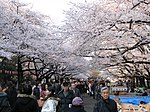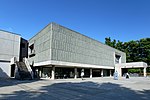Ueno Tōshō-gū
1627 establishments in JapanBuildings and structures in TaitōImportant Cultural Properties of JapanReligious buildings and structures completed in 1651Shinto shrines in Tokyo ... and 2 more
Tōshō-gūUeno Park

Ueno Tōshō-gū (上野東照宮) is a Tōshō-gū Shinto shrine located in the Taitō ward of Tokyo, Japan. First established in 1627 by Tōdō Takatora and renovated in 1651 by Tokugawa Iemitsu, the shrine has remained mostly intact since that time, making it a great example of Shinto architecture in the Edo period. Several of those surviving structures have been designated Important Cultural Properties.Tōshō-gū shrines are characterized by enshrining Tokugawa Ieyasu with the name Tōshō Daigongen (東照大権現). Ueno Tōshō-gū also enshrines two other Tokugawa shōguns, Tokugawa Yoshimune and Tokugawa Yoshinobu. Located inside of Ueno Park, Ueno Tōshō-gū has become a popular attraction.
Excerpt from the Wikipedia article Ueno Tōshō-gū (License: CC BY-SA 3.0, Authors, Images).Ueno Tōshō-gū
Dobutsuen Dori, Taito
Geographical coordinates (GPS) Address Website External links Nearby Places Show on map
Geographical coordinates (GPS)
| Latitude | Longitude |
|---|---|
| N 35.7154 ° | E 139.7706 ° |
Address
上野東照宮
Dobutsuen Dori
110-8711 Taito
Japan
Open on Google Maps











